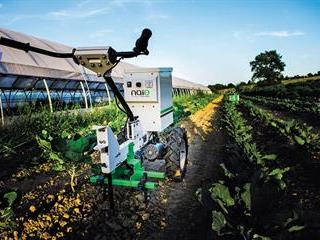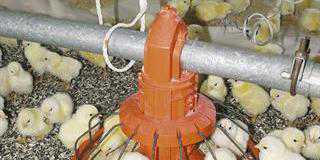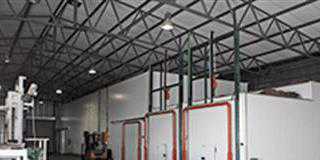
The Global Forum for Innovations in Agriculture was established to bring together public decision-makers, private sector pioneers and civil society leaders involved in the development of innovations to promote sustainable agriculture.
One of the key objectives of the forum, which convenes annually in Abu Dhabi in the United Arab Emirates, is to demonstrate how groundbreaking technologies can affect agriculture and ultimately help address the global challenge of meeting escalating food needs while using fewer resources.
Innovations presented at this year’s exhibition and conference in February, ranged from solutions for urban farming and aquaculture, hydroponics and aquaponics, to crops of the future that are high-yielding and more drought-resistant than conventional staple crops, and the use of information technology, drones and satellites to improve farming efficiency.
Mechanical weeding
Gaëtan Séverac, founder and director of Naïo Technologies based in France, presented the company’s autonomous navigation technologies (robots) that have been developed to help farmers save time and money.
A review of some of these products on freshplaza. com says that, according to Naïo Technologies, “the two robots that have thus far been developed could reduce the use of chemicals in farming while improving working conditions for farmers”.
Naïo’s first robot, the Oz weeding robot, of which 30 are already operational in the field, saves time spent on weeding. Describing the product on their website, the company says that the Oz weeds crop rows autonomously, providing for fully mechanical weed control instead of chemical control.
“The innovation of Oz lies in its capacity to move autonomously between rows using laser and camera guidance. Oz recognises different types of culture and moves accordingly when eliminating weeds.”
The robot is 40cm wide and 70cm long and can operate for four hours at a time. This, according to the developer, should enable it to complete work on 48 rows of 100m each.
Naïo’s second and slightly larger weed control device, the Cosi, does not operate autonomously; the farmer has to steer the machine, which removes weeds mechanically between crop rows.
It is a tool for assisted mechanical weeding and, according to Naïo, is ideal for smaller areas where it allows for “fast, efficient and effortless mechanical weeding control”.
The Cosi measures 46cm in width and 150cm in length. It is 100cm high and the wheels are spaced 30cm apart. In its description of the product, the developer says the machine can weed a 100m row effectively in under four minutes.
Reducing wastage
Arne Pauwels, founder of, and inventor for, Wakati in Belgium, presented a solution for farmers in undeveloped rural areas to keep their produce fresher for longer. The Wakati, a 1m3 tent structure, creates a sterilised micro-climate environment in which to store produce. The device uses a solar power system for its operation. According to a statement from the company, the device comprises a 3W solar panel, a tent-like structure in which up to 150kg of produce can be stored, and a solar-powered ventilator.
“The ventilator gradually evaporates a weekly supply of 200ml of water, creating a humid environment within the tent,” the developer explains.
In an interview with gizmag.com, Pauwels says that the humid environment created by the Wakati helps to reduce the extent to which crops dry out after being harvested, thus prolonging shelf life. Unlike a refrigerator, the Wakati does not control temperature and therefore cannot store fruit and vegetables for long periods. Pauwels told the technology news website that tests on the Wakati have shown, however, that a one- or two-day shelf life in a hot climate can be increased to 10 days.
Harvesting dew
Bassel Jouni, of Ethiopian-based Roots Up, presented a greenhouse that works by harvesting dew. The greenhouse is designed to efficiently harvest water from dew, from fog if placed in high locations, and from rain during the wet season.
According to Roots Up, the greenhouse is multifunctional: it can grow food and produce water.
“Inside, the hot air is trapped, so the temperature in the greenhouse keeps rising throughout the day. The heat causes water to evaporate, creating air humidity, making the greenhouse atmosphere better for plants’ growth as well as maximising the dew harvest,” the Roots Up website states.
During the night, when the surface temperature drops, the farmer opens the top of the greenhouse allowing it to cool, eventually reaching the dew point. At this point, atmospheric water vapour condenses to form small droplets on the surface of the bioplastic sheet. These fall into the water tank container.
The water collected is primarily meant for watering the crops contained within the greenhouse, but can be used as drinking water.
Email Gwendoline Legrand at Naïo Technologies at [email protected].
Visit www.naio-technologies.com.
Email Joris de Preter at Wakati at [email protected].
Visit www.wakati.org.
Email Bassel Jouni at Roots Up at info@roots-up. Visit www.roots-up.org.













